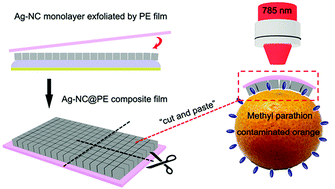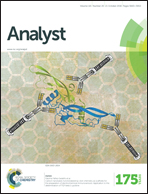A flexible transparent Ag-NC@PE film as a cut-and-paste SERS substrate for rapid in situ detection of organic pollutants†
Abstract
This report presents a simple and inexpensive fabrication approach to a flexible transparent composite film as a “cut-and-paste” surface-enhanced Raman scattering (SERS) substrate for in situ detection of organic pollutants. First, a self-assembled monolayer of Ag-nanocubes (Ag-NCs) is obtained at the air/water interface. Then, the Ag-NC monolayer is retrieved onto a flexible transparent polyethylene (PE) film to achieve an Ag-NC@PE composite film as a flexible SERS substrate. As the Ag-NCs in the monolayer are closely and uniformly packed on the PE film, the Ag-NC@PE composite film shows high SERS-activity with good signal homogeneity and reproducibility. Furthermore, the flexible transparent Ag-NC@PE composite film is “cut into” small pieces and directly “pasted” onto contaminated fruits for in situ SERS detection, as a result 10 nM thiram, 1 μM 4-polychlorinated biphenyl and 10 nM methyl parathion contaminants on oranges are detected, respectively. Therefore the Ag-NC@PE composite film is an inexpensive and effective SERS substrate for rapid in situ detection of organic pollutants in aqueous solutions, on fruits and other solid objects.


 Please wait while we load your content...
Please wait while we load your content...